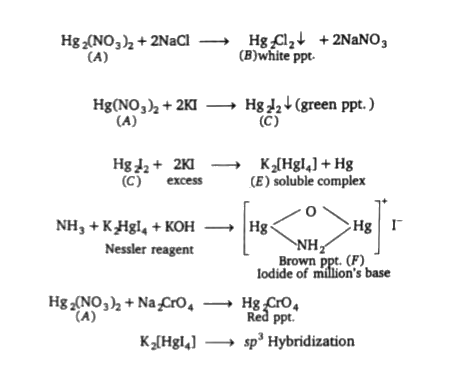(A)+NaCl→(B) (white ppt.)
(B)+Ki→(C) (green ppt).
(C)+KI(excess)→(D)+(E) (colourless solution)
(E)+NH3+KOH→(F)
Q. Type of hybridization in compound (E) is:
d2sp3
sp3d2
sp3
dsp2
The correct Answer is:C
Topper's Solved these Questions
- QUALITATIVE INORGANIC ANALYSISBOOK - VK JAISWALCHAPTER - QUALITATIVE INORGANIC ANALYSISEXERCISE - ONE OR MORE ANSWER IS/ARE CORRECT
45 Videos
- QUALITATIVE INORGANIC ANALYSISBOOK - VK JAISWALCHAPTER - QUALITATIVE INORGANIC ANALYSISEXERCISE - MATCH THE COLUMN
2 Videos
- QUALITATIVE INORGANIC ANALYSISBOOK - VK JAISWALCHAPTER - QUALITATIVE INORGANIC ANALYSISEXERCISE - LEVEL 2
75 Videos
- PERIODIC PROPERTIESBOOK - VK JAISWALCHAPTER - PERIODIC PROPERTIESEXERCISE - ASSERTION-REASON TYPE QUESTIONS
35 Videos
- s-BLOCK ELEMENTSBOOK - VK JAISWALCHAPTER - s-BLOCK ELEMENTSEXERCISE - SUBJECTIVE PROBLEMS
2 Videos
Similar Questions
Identify (A) to (H)
Mineral (A)dil.H2SO4−−−−−−→(B)+(C)+(D)(gas)
(D)+(CH3COO)2PbΔ−−→ black ppt
(B)+(C)(D)−−→E (black ppt)
separrated from (C ) by fitration
(E)+HNO3dilΔ−−→(F) (blue coloured solution)
(F)+K4[Fe(CN)6]→ chocolate colourer ppt
(C)+K3[Fe(CN)6]→ blue (H)
View SolutionNiCl2 solution + NH3 solution → Green ppt. excess−−−−−−−−→NH3 solution Deep blue solution
Finally Ni2+ ion is present in the
View Solution
Knowledge Check
(A)+NaCl→(B) (white ppt.)
(B)+Ki→(C) (green ppt).
(C)+KI(excess)→(D)+(E) (colourless solution)
(E)+NH3+KOH→(F)
Q. Colour of the compound (F) is:AYellowBBlueCWhiteDBrown(A)+NaCl→(B) (white ppt.)
(B)+Ki→(C) (green ppt).
(C)+KI(excess)→(D)+(E) (colourless solution)
(E)+NH3+KOH→(F)
Q. Compounds (A) and (B) are respectively:AAgNO3andAgClBPb(NO3)2andPbCl2CHg2(NO3)2andHg2Cl2DCu2(NO3)2andCu2Cl2(A)+NaCl→(B) (white ppt.)
(B)+Ki→(C) (green ppt).
(C)+KI(excess)→(D)+(E) (colourless solution)
(E)+NH3+KOH→(F)
Q. When compound (A) reacts with Na2CrO4 solution, the colour of the compound formed isAblackBredCyellowDwhite
Black solid KOH+Air−−−−−−→Δ(A)(green)H2SO4−−−→(B)(purple)+(C)
(i) KI on reaction with alkali solution of (B) changes into a compound (D).
(ii) The colour of the compound (B) disappears on treatment with the acidic solution of FeSO4
(iii) With cold conc. H2SO4 compound (B) gives (E), which being explosive decomposes to yield (F) and oxygen. ltBrgt Q. Type of hybridization in compound (D) is:
View SolutionAq. Suspension of a yellow substance (A)KI−−−−−−−→conc.solution colurless solution (B)NH4CI−−−−−−−−−−−→KOH solution added Brown ppt. Compound (A) is:
View Solution
B+NaOH→Dirty green ppt. NH3−−−−→(excess) Insoluble
Find the option where blut ppt is obtained.
View SolutionBlack solid KOH+Air−−−−−−→Δ(A)(green)H2SO4−−−→(B)(purple)+(C)
(i) KI on reaction with alkali solution of (B) changes into a compound (D).
(ii) The colour of the compound (B) disappears on treatment with the acidic solution of FeSO4
(iii) With cold conc. H2SO4 compound (B) gives (E), which being explosive decomposes to yield (F) and oxygen. ltBrgt Q. Nature of compound (E) is:
View SolutionBlack solid KOH+Air−−−−−−→Δ(A)(green)H2SO4−−−→(B)(purple)+(C)
(i) KI on reaction with alkali solution of (B) changes into a compound (D).
(ii) The colour of the compound (B) disappears on treatment with the acidic solution of FeSO4
(iii) With cold conc. H2SO4 compound (B) gives (E), which being explosive decomposes to yield (F) and oxygen. ltBrgt Q. Which of the following options is correct?
View Solution

